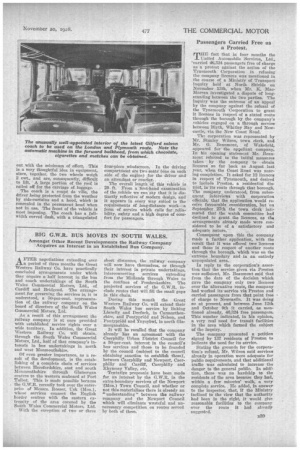A SIX-WHEELER FOR LONG-DISTANCE WORK.
Page 34

Page 35

If you've noticed an error in this article please click here to report it so we can fix it.
A Well-appointed Vehicle which has been Built for Use on the London to Plymouth Route.
ANESSRS. ASKEW AND SONS, of 1)j_Loughton, Essex, will soon be putting into' servies a new' Gilford sixwheeled saloon coach, fitted with a sixcylindered engine, brakes on all wheels and forward Isteering, the coachwork being by Duple Bodies. and Motors, Ltd., Of The Hyde, Hendon, London, N.W.9. The vehicle is to be run daily on a route between London and Plymouth, and is built to seat 33 persons, the seats being disposed transversely.
The coach is fitted with staggered seats upholstered in brown hide and finished at the edges with round headed oxidized nails. Most of the seats have an arm on the gangway side, but in the case of those aver the -wheelarches there is also an arm on the inside. The distance between the floor of the coach and the bottom of the seats is /8 ins., and the width of the double seats is 34 ins.; the leg-room appears to be ample. Each seat is provided with an ash-tray, a rug-rail and a footrest. Luggage space beneath each seat is another feature of this vehicle.
At regular intervals along the sides of the coach are push-bells, which enable communication to be made with the driver. Parcel racks are provided, these being situated at the cant-rail level. In the centre of the forward bulkhead is a machine containing supplies of chocolate, matches and cigarettes.
The interior lighting is by opal lamps, these being disposed at intervals of about 4 ft. along the body sides, two lamps on the back panel, which give a diffused light, and a concealed pilotlight in the roof. With the exception of the last-named, all the interior lights have separate switches. Apart from the
regulation tail-light, there arc two other lights, built into the rounded hind cornets, between the waist-rail and roof-line, and these serve to mark the extreme width of the vehicle.
The passengers enter by„tvso doors, one at the front and the _other behind the rear bogie. There is a single step to each door, the step forming a deep and convenient well, which makes for easy and safe mounting and dismounting; a kicking-plate is provided in each well. As the doors are of full depth and completely enclose the step wells, a hinged platform fixed to the• door panel is employed to cover the opening when the vehicle is travelling. As the door is opened so this platform automatically rises with it.
The vehicle is ventilated by three Airvac devices fitted at intervals in the roof. The windows are of the winding pattern, and can be lowered almost to the full extent ; overlapping louvre yens tilators enable the main lights to be opened an inch or two without fear of a draught being set up. It is interesting to note that the louvres serve the double purpose of ventilating and displaying the names of the important towns passed on the journey from Plymouth to London
There is ample locker accommodation in the skirt of the body, and the four rear wheels are enclosed by a hinged cover which follows the main body line, except that it is cut away to give ready access to the hub-caps. This method minimizes the risk of damage to paintwork caused by mud splashes.
In the rear panel of the coach is a locker in which two spare wheels are stored. These wheels rest on a carrier, so that they can easily be slid in and
out with the minimum of effort This is a very thoughtful idea in equipment, since, together, the two wheels weigh 2 cwt, and are, consequently, .difficult to lift. ' A large portion of the roof is railed off for the carriage of luggage.
The coach is a coupe de yule, the driver being protected from the weather by side-curtains and a hood, which is concealed in the permanent head when not in use. The front of the vehicle is most imposing. The coach has a fullwidth curved dash, with a triangulated
four-piece windscreen. In the driving compartnient are two seats (one on each' side of the engine) for the driver and an attendant or courier.
The overall length of this vehicle is 29 ft. From a 'first-hand examination of the vehicle we can say that it is distinctly reflective of modern design, and it appears in every way suited to the requirements of long-distance work—a form of service which calls for reliability, safety and a high degree of corn:, fort for passengers.








































